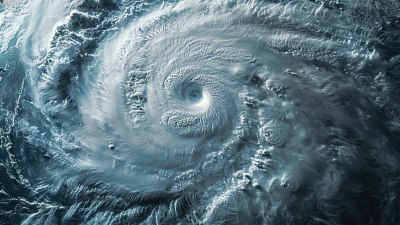Why the Ocean Feels Like a Bathtub One Day and an Ice Bucket the Next
Explore the factors causing ocean temperature variations and why it feels different day to day.

This image was created with the assistance of Freepik
The ocean is vast and mysterious, often creating a sensory experience for those who come into contact with it. One day you might step into the water and be greeted by a warm, inviting sensation reminiscent of a luxurious bathtub. The next, you might find yourself shivering from the shock of icy waters that feel more like an ice bucket. This fluctuation in temperature can be attributed to a variety of factors, including seasonal changes, geographical location, ocean currents, and even weather patterns. Let's delve into the reasons behind these contrasting experiences in ocean temperatures.
Seasonal Changes and Their Impact
One of the most significant factors affecting ocean temperature is the seasonal cycle. In tropical regions, the ocean is generally warm year-round, often exceeding 80°F (27°C). However, during transition periods like spring and fall, the water can alternate between warm and cool temperatures. In temperate zones, summer months might see surface temperatures rise, creating conditions akin to a bathtub, while winter months bring much cooler waters. These seasonal changes create stark contrasts, affecting how we perceive ocean temperatures on any given day.
Geographical Influence
Geography plays a pivotal role in how the ocean feels. Coastal areas can experience dramatically different temperatures based on their latitude and proximity to the equator. For instance, waters near the equator remain consistently warm, while areas further from the equator can face significant temperature variations. Additionally, coastal features such as bays may trap warmer water, creating local pockets of warmth, while open ocean areas may experience cooler temperatures. Thus, where you are swimming can greatly influence your experience.
Ocean Currents and Temperature Variation
Ocean currents are another crucial factor in ocean temperature fluctuations. These currents, driven by wind patterns and Earth's rotation, can move warm waters from the equator towards the poles and colder waters back towards the equator. For example, the Gulf Stream transports warm water from the Gulf of Mexico to the North Atlantic, raising temperatures along the eastern coast of the United States. Conversely, cold currents, such as the California Current, can significantly cool down water temperatures along the West Coast. The presence of these currents can lead to dramatic changes in temperature, sometimes within just a few days.
Weather Patterns and Temperature Perception
Weather conditions can also play a significant role in how we perceive ocean temperatures. A sunny day can warm the surface waters through solar radiation, creating that bath-like feeling we often cherish on summer outings. Conversely, overcast skies and cold fronts can chill the water and atmosphere, resulting in intensely cold sensations. Rainfall can also mix with saltwater, leading to varying temperatures, especially near the shore. A warm rain shower can momentarily raise the surface temperature, while heavy rains can lead to a chill as cooler freshwater mixes with the ocean.
Temperature Gradients
Within the ocean, temperature gradients often develop. This occurs when the surface water warms up by absorbing sunlight while deeper water remains cold and dense. When you first step into the ocean, you may encounter relatively warm surface water, only to be surprised by a sudden drop in temperature as you dive deeper. This thermocline, a barrier of temperature difference, can create stark contrasts in sensation. The deeper you go, the colder the water becomes, and this can lead to the ice bucket feeling when you venture below the pleasant warmth.
Influence of Tides
Tides can also impact how the ocean feels. Depending on the time of day, the tidal movements can affect how warm or cold the water is. During low tide, warmer water may be exposed to air for longer, while high tide can draw in cooler water from deeper depths, creating a quick shift in temperature. This motion within the water column causes sensations to shift rapidly, explaining the difference in experience from day to day.
Effects of Human Activity
Human activities can further enhance geographical differences in ocean temperature. Coastal cities often have warmer waters due to runoff from developed areas, industrial activities, and urban heat islands. Agricultural practices can also lead to runoff affecting local water temperatures. Additionally, climate change has implications for the ocean, as rising temperatures alter ecosystems and shift weather patterns. These changes can create more significant fluctuations in how the ocean feels on a daily basis, influencing our experience.
Ecological Factors
The ocean is home to various ecosystems that can shape its temperature. Coral reefs, for instance, often raise local water temperatures. When swimming near a reef, you may experience warmer waters, particularly if the weather is sunny. Similarly, seaweed beds can trap heat, creating locally warmer conditions. These ecological factors add another layer of variability to the temperature, contributing to how we perceive or feel about it on any given day.
The Ocean's Intricate System
Understanding the ocean as an intricate system reveals why temperatures fluctuate so much. Solar energy drives many processes, from evaporation and weather formation to ocean currents. Each element interacts within a larger system, leading to temperature variations that are both predictable and surprising. This interconnectedness makes it impossible to pinpoint one single cause for why the ocean feels like a bathtub one day and an ice bucket the next.
In conclusion, the experience of stepping into ocean water can vary dramatically based on a multitude of factors, including seasonal changes, geographical influence, ocean currents, weather patterns, and more. Whether you find the water warm and inviting or icy and shocking, it's all part of nature's intricate balance. A deeper understanding of these factors enriches our appreciation for the ocean and serves as a reminder of the fascinating world beneath the waves. So the next time you encounter the ocean, take a moment to reflect on the complex interplay of conditions that creates your sensory experience. Enjoy the varying sensations and let the ocean remind you of its ever-changing beauty.











